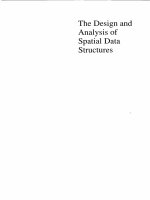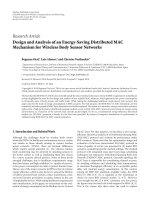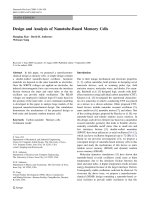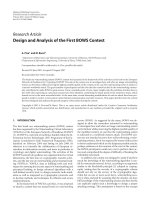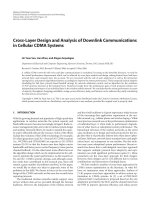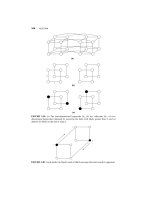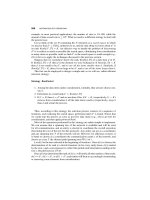Design and analysis of load balancing scheduling strategies on distributed computer networks using virtual routing approach
Bạn đang xem bản rút gọn của tài liệu. Xem và tải ngay bản đầy đủ của tài liệu tại đây (1.19 MB, 153 trang )
DESIGN AND ANALYSIS OF LOAD
BALANCING/SCHEDULING STRATEGIES
ON DISTRIBUTED COMPUTER NETWORKS
USING VIRTUAL ROUTING APPROACH
ZENG ZENG
(M. Eng., Huazhong University of Science and Technology, PRC )
A THESIS SUBMITTED
FOR THE DEGREE OF DOCTOR OF PHILOSOPHY
DEPARTMENT OF ELECTRICAL & COMPUTER ENGINEERING
NATIONAL UNIVERSITY OF SINGAPORE
2004
i
Acknowledgements
Firstly of all, I would like to express my deepest gratitude and appreciation to my supervisor,
Assistant Professor Bharadwaj Veeravalli, for his continuous guidance, constant encourage-
ment and rigorous research attitude during the course of my research. It is a pleasant time
to work with him during the past three year and he has made my research experience at the
National University of Singapore (NUS) an invaluable treasure for my whole life.
My special thanks to my devoted parents for their love, encouragement and support
throughout my life. They always stand by my side and provide me the safest harbor in
the world. As the only child of the family, I have done little for them and own them too
much.
My thanks also go to all my friends in Open Source Software Lab, in NUS, for their help
and support to solve the technical and analytical problems. The friendship with them makes
my study and life in NUS fruitful and unforgettable.
Finally, I would like to thank NUS for granting me the research scholarship and providing
me the facilities that make the research a success.
ii
Contents
Acknowledgements i
Contents ii
List of Figures v
List of Tables viii
Summary ix
1 Introduction 1
1.1 Related Work . . . . . . . . . . . . . . . . . . . . . . . . . . . . . . . . . . . . 4
1.2 Issues to Be Studied and Main Contributions . . . . . . . . . . . . . . . . . . . 7
1.3 Organization of the Thesis . . . . . . . . . . . . . . . . . . . . . . . . . . . . . 11
2 System Modelling 13
2.1 Models for Processing Loads . . . . . . . . . . . . . . . . . . . . . . . . . . . . 13
2.2 Arbitrary Network Topology . . . . . . . . . . . . . . . . . . . . . . . . . . . . 15
2.3 Mathematical Models and Some Definitions . . . . . . . . . . . . . . . . . . . 15
2.3.1 Processor models . . . . . . . . . . . . . . . . . . . . . . . . . . . . . . 16
2.3.2 Communication link models . . . . . . . . . . . . . . . . . . . . . . . . 17
2.3.3 Some notations and definitions . . . . . . . . . . . . . . . . . . . . . . 18
iii
2.3.4 Correspondence between routing and load balancing . . . . . . . . . . . 19
2.4 Concluding Remarks . . . . . . . . . . . . . . . . . . . . . . . . . . . . . . . . 20
3 Distributed Static Load Balancing Strategies for Multi-class jobs 21
3.1 Problem Formulation . . . . . . . . . . . . . . . . . . . . . . . . . . . . . . . . 23
3.2 Proposed solution . . . . . . . . . . . . . . . . . . . . . . . . . . . . . . . . . . 27
3.3 Proposed Algorithm and An Optimal Solution . . . . . . . . . . . . . . . . . . 29
3.3.1 Optimal solution . . . . . . . . . . . . . . . . . . . . . . . . . . . . . . 29
3.3.2 Design of the proposed algorithm . . . . . . . . . . . . . . . . . . . . . 34
3.3.3 Rate of convergence . . . . . . . . . . . . . . . . . . . . . . . . . . . . . 38
3.4 Experimental Results and Discussions . . . . . . . . . . . . . . . . . . . . . . . 40
3.4.1 LK algorithm in brief . . . . . . . . . . . . . . . . . . . . . . . . . . . . 41
3.4.2 Demonstration of LBVR algorithm: An example of load balancing . . . 42
3.4.3 Studies on more network topologies . . . . . . . . . . . . . . . . . . . . 49
3.5 Concluding Remarks . . . . . . . . . . . . . . . . . . . . . . . . . . . . . . . . 53
4 Distributed Dynamic Load Balancing Strategies 55
4.1 System Model and Classification of Dynamic Load Balancing Algorithms . . . 57
4.2 Comparative Study on the Algorithms . . . . . . . . . . . . . . . . . . . . . . 60
4.2.1 ELISA: Estimated Load Information Scheduling algorithm . . . . . . . 61
4.2.2 The proposed algorithm: RLBVR . . . . . . . . . . . . . . . . . . . . . 61
4.2.3 The proposed algorithm: QLBVR . . . . . . . . . . . . . . . . . . . . . 67
4.3 Performance Evaluation and Discussions . . . . . . . . . . . . . . . . . . . . . 69
4.3.1 Two-processor system model and some important issues . . . . . . . . 70
4.3.2 Effect of system loading . . . . . . . . . . . . . . . . . . . . . . . . . . 72
4.3.3 Effect of T
s
: Length of status exchange interval . . . . . . . . . . . . . 74
4.4 Extensions to Large Scale Multiprocessors System . . . . . . . . . . . . . . . . 77
iv
4.4.1 Static or slowly varying system loading . . . . . . . . . . . . . . . . . . 80
4.4.2 Experiments when arrival of loads is varying rapidly . . . . . . . . . . . 82
4.5 Concluding Remarks . . . . . . . . . . . . . . . . . . . . . . . . . . . . . . . . 84
5 Extensions to Divisible Loads Scheduling on Arbitrary Networks 86
5.1 Mathematical Model and Problem Formulation . . . . . . . . . . . . . . . . . 88
5.1.1 Description of system, assumptions and notations . . . . . . . . . . . . 88
5.1.2 Problem formulation . . . . . . . . . . . . . . . . . . . . . . . . . . . . 91
5.2 Proposed Strategy for Optimal Solution . . . . . . . . . . . . . . . . . . . . . 93
5.2.1 Sub-algorithm for a node and optimal sequence . . . . . . . . . . . . . 93
5.2.2 Scheduling strategy for an arbitrary topology . . . . . . . . . . . . . . 98
5.2.3 Convergence and complexity of the algorithm . . . . . . . . . . . . . . 106
5.3 Simulation Results and Some Discussions . . . . . . . . . . . . . . . . . . . . . 111
5.3.1 Demonstration: An example of optimal scheduling . . . . . . . . . . . . 112
5.3.2 Performance comparison of algorithms . . . . . . . . . . . . . . . . . . 114
5.3.3 Divisible loads originating from multiple sites . . . . . . . . . . . . . . 119
5.4 Concluding Remarks . . . . . . . . . . . . . . . . . . . . . . . . . . . . . . . . 121
6 Conclusions and Future Work 124
Bibliography 129
Author’s Publications 140
Appendix: Queue Length Estimation 141
v
List of Figures
1.1 A distributed/parallel computer system. . . . . . . . . . . . . . . . . . . . . . 2
2.1 A distributed/parallel computer system. . . . . . . . . . . . . . . . . . . . . . 15
2.2 Server model of node i. . . . . . . . . . . . . . . . . . . . . . . . . . . . . . . . 16
3.1 Job flows in node i. . . . . . . . . . . . . . . . . . . . . . . . . . . . . . . . . . 24
3.2 Example of job flows and the delays. . . . . . . . . . . . . . . . . . . . . . . . 26
3.3 Job flows in a system with a virtual node. . . . . . . . . . . . . . . . . . . . . 27
3.4 Routing paths for each node. . . . . . . . . . . . . . . . . . . . . . . . . . . . . 30
3.5 Operation of the prop osed algorithm. . . . . . . . . . . . . . . . . . . . . . . . 40
3.6 An example of a 9-node distributed computer system. . . . . . . . . . . . . . . 43
3.7 A distributed computer system with a virtual node d. . . . . . . . . . . . . . . 47
3.8 Comparison of the algorithms with respect to computational time. . . . . . . . 47
3.9 An example of a 9-node Ring computer system. . . . . . . . . . . . . . . . . . 50
3.10 Comparison of algorithms on Ring network. . . . . . . . . . . . . . . . . . . . 50
3.11 An example of a 9-node arbitrary network. . . . . . . . . . . . . . . . . . . . . 51
3.12 Comparison of algorithms on an arbitrary network. . . . . . . . . . . . . . . . 52
4.1 Node model for queue adjustment policy. . . . . . . . . . . . . . . . . . . . . . 58
4.2 Node model for rate adjustment policy. . . . . . . . . . . . . . . . . . . . . . . 59
4.3 Node model for the combination of queue and rate adjustment policy. . . . . . 60
vi
4.4 Intervals of estimation and status exchange. . . . . . . . . . . . . . . . . . . . 61
4.5 Model of a 2-pro cessor system. . . . . . . . . . . . . . . . . . . . . . . . . . . . 70
4.6 Job arrival rate pattern. . . . . . . . . . . . . . . . . . . . . . . . . . . . . . . 71
4.7 Effect of system loading. . . . . . . . . . . . . . . . . . . . . . . . . . . . . . . 73
4.8 Effect of T
s
: System loading is light. . . . . . . . . . . . . . . . . . . . . . . . 75
4.9 Effect of T
s
: System loading is moderate. . . . . . . . . . . . . . . . . . . . . . 76
4.10 Effect of T
s
: system loading is high. . . . . . . . . . . . . . . . . . . . . . . . . 77
4.11 A mesh-connected multiprocessor M[8, 8] system. . . . . . . . . . . . . . . . . 78
4.12 Mean response time of jobs for 5 different algorithms under different system
utilization: System utilization is light or moderate (ρ < 0.75). . . . . . . . . . 81
4.13 Mean response time of jobs for 5 different algorithms under different system
utilization: System utilization is high (ρ > 0.75). . . . . . . . . . . . . . . . . . 81
4.14 An example of the job pattern. . . . . . . . . . . . . . . . . . . . . . . . . . . 83
5.1 An arbitrary computer network system with multiple loads. . . . . . . . . . . . 89
5.2 Single-level tree topology. . . . . . . . . . . . . . . . . . . . . . . . . . . . . . 93
5.3 Single-level tree with virtual node and virtual links. . . . . . . . . . . . . . . . 96
5.4 Results of Example 5.1: d
max
1
and d
max
1
− d
min
1
in each iteration r. . . . . . . . 96
5.5 The iteration procedure of the proposed algorithm. . . . . . . . . . . . . . . . 109
5.6 Experiment 5.1: (a) An arbitrary network; (b) Optimal sequence of node 1; (c)
Optimal sequence of node 5. . . . . . . . . . . . . . . . . . . . . . . . . . . . . 112
5.7 Results of Experiment 5.1: T
max(r)
and T
max(r)
− T
min(r)
in each iteration r. . 114
5.8 Results of Experiment 5.1: Timing diagram. . . . . . . . . . . . . . . . . . . . 115
5.9 Experiment 5.2: An arbitrary network with 10 nodes. . . . . . . . . . . . . . . 116
5.10 Results of Experiment 5.2: Timing diagram of the proposed algorithm when
divisible loads originating from node 10. . . . . . . . . . . . . . . . . . . . . . 117
vii
5.11 Example 5.2, load flow: (a) A simple example with three nodes; (b) MST with
root node 1; (c) The single-level tree; (d) Our proposed algorithm. . . . . . . . 118
5.12 Experiment 3, a 9 nodes system: (a) A sparse connection; (b) A medium dense
connection; (c) A dense connection. . . . . . . . . . . . . . . . . . . . . . . . . 120
5.13 The timing diagram of the 9-node system when the connection is medium dense.121
viii
List of Tables
3.1 Proposed Load Balancing Algorithm (LBVR) . . . . . . . . . . . . . . . . . . 39
3.2 Parameter values of node model . . . . . . . . . . . . . . . . . . . . . . . . . . 45
3.3 Average external job arrival rates for class-1 and class-2 jobs . . . . . . . . . . 46
3.4 Completed job rate (β
k
i
) in node i . . . . . . . . . . . . . . . . . . . . . . . . . 48
3.5 Parameters of each node in the system . . . . . . . . . . . . . . . . . . . . . . 52
4.1 Main structure of ELISA . . . . . . . . . . . . . . . . . . . . . . . . . . . . . . 62
4.2 Procedure for Node . . . . . . . . . . . . . . . . . . . . . . . . . . . . . . . . . 68
4.3 MRT of 5 algorithms in the 8 × 8 mesh multiprocessor system (sec.) . . . . . . 84
5.1 Brute-force search results for optimal sequence of Example 5.1 . . . . . . . . . 98
5.2 Proposed Scheduling Strategy for Loads Originating from Multiple Sites (Step
1) . . . . . . . . . . . . . . . . . . . . . . . . . . . . . . . . . . . . . . . . . . . 104
5.3 Proposed Scheduling Strategy for Loads Originating from Multiple Sites (Step
2) . . . . . . . . . . . . . . . . . . . . . . . . . . . . . . . . . . . . . . . . . . . 105
5.4 Proposed Scheduling Strategy for Loads Originating from Multiple Sites (Step
3) . . . . . . . . . . . . . . . . . . . . . . . . . . . . . . . . . . . . . . . . . . . 106
5.5 Computational results for load distribution with different load origination . . . 116
5.6 Computational results of Experiment 5.3 (unit load) . . . . . . . . . . . . . . . 120
ix
Summary
Parallel and distributed heterogeneous computing has been proven to be an efficient and
successful way for various applications. There are several performance metrics to quantify the
performances of a distributed system. In this thesis, we consider the problem of load balancing
in distributed systems. Specifically, we consider balancing indivisible loads across the network
nodes so as to achieve an optimal response time. We first present the underlying mathematical
model that takes into account several complex and influencing real-time scenarios of load
balancing and scheduling. In this thesis, we attempt to employ a novel idea in which we use
the concept of virtual routing for balancing the work loads among the nodes. This is the first
time in this domain such an attempt is made. For each of the real-life scenarios considered,
the problem is carefully decomposed into sub-problems and distributed strategies by virtual
routing approach are derived systematically.
For indivisible jobs, minimizing the mean response time of the jobs submitted for process-
ing is a critical performance metric to be considered for improving the overall performance of
the distributed computer system. In this thesis, we propose both the static and dynamic load
balancing algorithms for handling single-class or multi-class jobs in the distributed network
system for minimizing the mean response time of the jobs, using the concept of virtual rout-
ing. We employ a novel approach to transform the load balancing problem into an equivalent
routing problem and propose a static algorithm, referred to as Load Balancing via Virtual
Routing (LBVR). We show that the design of LBVR subsumes several interesting properties
x
and guarantees to deliver a super-linear rate of convergence in obtaining an optimal solution,
whenever it exists.
We classify the distributed, dynamic load balancing algorithms into three policies: queue
adjustment policy (QAP), rate adjustment policy (RAP) and Queue and Rate Adjustment Pol-
icy (QRAP). On the basis of LBVR, we propose two efficient dynamic algorithms, referred to
as Rate based Load Balancing via Virtual Routing (RLBVR) and Queue based Load Balancing
via Virtual Routing (QLBVR), which belong to the above RAP and QRAP policies, respec-
tively. Our focus is to analyze and understand the behaviors of these algorithms in terms of
their load balancing abilities under varying load conditions (light, moderate, or high) and the
minimization of mean response time of the jobs. We compare the above classes of algorithms
by a number of rigorous simulation experiments to elicit their behavior under some influencing
parameters such as, load on the system and status exchange intervals. We also extend our
experimental verification to large scale multiprocessor systems such as Mesh architecture that
is widely used in real-life situations. Recommendations are drawn to prescribe the suitability
of the algorithms under various situations.
Finally, we extend our analysis and design of algorithms to the case of scheduling large vol-
ume computational loads (divisible loads) originating from single or multiple sites on arbitrary
networks. It is first time in divisible load theory (DLT) that such a generalized mathematical
model is presented and the scheduling problem is formulated as an optimization problem with
an objective to minimize the processing time of the loads. We present a number of theoretical
results on the solution of the optimization problem. On the basis of these results, we propose
an efficient algorithm for scheduling divisible loads using the concept of load balancing via
virtual routing for an arbitrary network configuration. When divisible loads originate from
single node, we compare the proposed algorithm with a recently proposed RAOLD algorithm
in the literature which is based on minimum cost spanning tree. When divisible loads origi-
nate from multiple sites, we testify the performance on sparse, medium and densely connected
xi
networks. Detailed performance analysis and comparison are conducted.
Further study in the research areas of indivisible load balancing and divisible load schedul-
ing are quite promising. Several possible extensions of our research are addressed at the end
of this thesis.
1
Chapter 1
Introduction
Distributed computer systems have emerged as a powerful computing means for real-time
applications, such as nuclear plant control and avionic control [1], image feature extraction [2]
and biological sequence alignment [3], etc. We consider a generic distributed/parallel com-
puter system shown in Fig. 1.1. The system consists of n heterogeneous nodes, which represent
host computers, interconnected by a generally configured communication/intercommunication
network. Each processor in the system may receive one or more classes of jobs independently
and each node consists of one or more resources (such as CPU, I/O devices, etc), contended
for by the jobs processed at that node. Further, these nodes may differ in configurations
such as, speed characteristics, buffer sizes, and number of resources. However, we assume
that they have the same processing capabilities. For instance, a job can be processed at any
node without interruption. Compared to a single computer system, a distributed computer
system generally provides significant advantages, such as better performance, better scalabil-
ity, better reliability and better resource sharing [4], and distributed computer systems have
attracted more and more research efforts in the past two decades [5–11].
Balancing or scheduling the work loads over a distributed computer network system is im-
portant to improve the overall performance. In such a system, if some hosts remain idle while
others are extremely busy, system performance will be affected drastically. To prevent this,
Chapter 1 Introduction 2
Figure 1.1: A distributed/parallel computer system.
load balancing and load scheduling are often used to distribute the loads and improve perfor-
mance measures such as the mean response time (MRT) of a job, which is the time difference
between the time instant at which a job arrives at the system and the time instant at which
the job gets processed [12,13], the total time of processing all the loads [14,15]. The design of
such load balancing and load scheduling algorithms, in general, considers several influencing
factors, such as the underlying network topology, communication network bandwidth at each
processor in the system, etc. The computers in the system are also considered and they can
be classified as either homogeneous with the same computing characteristics or heterogeneous
with different processing capabilities, buffer sizes limited or infinite, etc. Furthermore, while
considering job characteristics, there may exist several variations, such as priority assignment
for jobs in processing, jobs with or without deadlines, etc. For convenience, in the rest of this
thesis, we use load and job interchangeably.
Based on the types of loads under processing, load balancing or scheduling problems can
be classified into two categories: indivisible load balancing and divisible load scheduling.
Indivisible loads are atomic and cannot be divided into smaller sub-tasks, and have to be
processed in its entirety on a processor. The indivisible jobs are assumed to arrive at each
node according to an ergodic process (e.g., Poisson process). Each node determines whether
jobs will be processed locally or transferred to another node for processing. Load balancing
Chapter 1 Introduction 3
strategies attempt to distribute the indivisible jobs to be processed, according to some op-
timal solutions, to make the whole system balanced. Divisible loads are data parallel loads
that are arbitrarily partitionable amongst nodes of the network. In contrast to the indivisible
loads model, divisible loads are assumed to be very large in size, homogeneous, and arbi-
trarily divisible in the sense that, each partitioned portion of the loads can be independently
processed on any processor in the system [15, 16]. The theory of scheduling and processing
of divisible loads, referred to as Divisible Load Theory (DLT), has stimulated considerable
interest among researchers in the field of parallel and distributed systems since its origin in
1988 [17,18]. Hence, load scheduling is the study of how to obtain an optimal fraction of a
large divisible load for each node in a distributed computer system.
Load balancing algorithms can be classified as either dynamic or static, based on the
information that can be used. A dynamic algorithm [19–23] makes its decision according to
the current status of the system, where the status could refer to some types of information
such as the number of jobs waiting in the queue, the current job arrival rate, the job processing
rate, etc, at each pro cessor. On the other hand, a static algorithm [5, 12, 24, 25] is carried
out by a predetermined policy, without considering the status of the system. The primary
concern in the research of DLT is to determine the optimal fractions of the entire loads to be
assigned to each of the processors in such a way that the total processing time of the entire
loads is a minimum. Compilation of all the research contributions in DLT until 1995 can be
found in monographs [1, 15]. Two recent survey articles [16, 26] consolidate all the results
until 2002.
Below, we shall discuss some related work in both load balancing and scheduling research
areas.
Chapter 1 Introduction 4
1.1 Related Work
For studying the load balancing problems, many models of computer networks, processors and
jobs have been developed. For example, the models of networks can be classified according
to the topologies of the networks [27], such as star, ring and bus. The processors can be
modelled as M/M/1 queuing systems with a single or several queues to hold the jobs waiting for
processing [28]. In the existing literature, several combinations of different mo dels of computer
network, processor and jobs are discussed and other issues such as sender-initiated strategies,
receiver-initiated strategies are prop osed for load balancing [29]. In sender-initiated policies,
congested processors attempt to transfer jobs to lightly loaded processors. In receiver-initiated
policies, lightly loaded processors search for congested processors from which jobs may be
transferred. In [30, 31], the authors compared the performance of the two policies and found
that in most situations, sender-initiated policies provided generally better performance than
receiver-initiated policies [7]. An excellent compilation of most of the load balancing/sharing
algorithms until 1992 can be found in [8].
Static load balancing algorithms are widely used in large-scale simulations [1], parallel
program [32], etc. For static algorithms, there are some differences among the network con-
figurations. In [5,33], Tantawi and Towsley studied optimal static load balancing in star and
bus network configurations [34]. On the basis of their work, Kim and Kameda [35] proposed
two improved algorithms for load balancing in star and bus network configurations, respec-
tively. Load balancing problems in star and tree network configurations with two-way traffic
were studied in [36,37]. In [5,38], the algorithms proposed were concerned about an arbitrary
network configuration and hence, became more applicable in a practical distributed computer
system. However, the contributions mentioned above considered only a single class of jobs.
In practice [25], the jobs in the system were divided into several classes and each class of
jobs had its own priority. Kim and Kameda studied the optimal load balancing problem for
multi-class jobs in bus configured distributed computer system [39]. In [12], Li and Kameda
Chapter 1 Introduction 5
proposed a load balancing algorithm for multi-class jobs in an arbitrary network. It is an
important work to analyze the load balancing problems for multi-class jobs. The study of
multi-class jobs makes the system more flexible to handle different classes of jobs and is a
right step in generalizing the study.
Dynamic load balancing algorithms offer the possibility of improving load distribution
at the expense of additional communication and computation overheads. In [23, 40], it was
pointed out that the overheads of dynamic load balancing may be large, especially for a
large heterogeneous distributed system. Hence, most of the research works in the literature
focused on centralized dynamic load balancing [23,41], in which an Management Station (M-
Station)/Balancer kept checking the system status and balanced the arriving jobs among the
processors by some strategies, such as Backfilling [42], Gang-Scheduling, and Migration [81],
etc. By centralization, the M-Station/Balancer can handle most of the communication and
computation overheads efficiently, and improve the system performance. However, the central-
ization limits the scalability of the parallel system and the trend of larger distributed computer
system makes M-Station/Balancer to become the system bottleneck. Because of its scalabil-
ity, flexibility and reliability, distributed dynamic load balancing offers more advantages than
the centralized strategies, and thus has obtained more and more focuses recently [19,43].
To realize a distributed working style, each processor in the system shall handle its own
communication and computation overheads independently [10,12]. In order to reduce the com-
munication overheads, Anand et. al., [19] proposed an estimated load information scheduling
algorithm (ELISA) and Michael [44] analyzed the usefulness of the extent to which old infor-
mation can be used to estimate the status of the system. In [45–47], the authors have proven
the correctness using randomization techniques, leading to an exponential improvement in
balancing the loads. To obtain optimal solutions among the system, the computation over-
heads remain still high. For example, Jie-Kameda algorithm needs more than 400 seconds
(approx) and even a well-known FD algorithm [48] needs more than 10
5
seconds to solve a
Chapter 1 Introduction 6
generic case [12]. However, in this thesis, we propose an algorithm named load balancing via
virtual routing (LBVR) and prove that the convergence rate of LBVR is super-linear. High
convergence rate can reduce the computation overheads significantly.
Numerous studies have been conducted in the DLT literature and a criterion that is used
to derive optimal solution is as follows. It states that in order to obtain an optimal processing
time, it is necessary and sufficient that all the processors participating in the processing must
stop at the same time instance. This condition is referred to as an optimality principle in the
DLT literature and analytic proof can be found in [15,49,50]. In 1998, Barlas [51] presented
an important result concerning an optimal sequencing in a tree network and it is one of
the important studies that demonstrates the performance of the load distribution algorithm
when result collection phase is included in the problem formulation. In [52], a multi-level
tree is considered and it is assumed that the load distribution takes place concurrently from
a source processor to all its immediate child processors. This is one of the earliest attempts
in using a multi-port model of communication, in which all the incident links on a processor
are concurrently used. The advantage of the multi-port model was also demonstrated in a
two-dimensional mesh network [53]. In [54], load partitioning of intensive computations of
large matrix-vector products in a multi-cast bus network was investigated.
To determine the ultimate speedup using DLT analysis, Li [55] conducted an asymptotic
analysis for partitionable network topologies. Here speedup is the ratio of solution time on
one processor to solution time on N processors and is thus a measure of achievable parallel
processing advantage. Most recent studies focus on system dependent constraints such as,
scheduling under finite buffer capacity constraints [56], estimating the processor and link
speeds by some methods of probing and estimating [57], scheduling divisible loads on Mesh
multiprocessor architectures [58], to quote a few. Also, the applicability of DLT concepts to
schedule and process loads generated from large scale physics experiments (RHIC at BNL,
USA) on computational grids were investigated in [59]. Finally, use of affine delay models for
Chapter 1 Introduction 7
communication and computation components for scheduling divisible loads were extensively
studied in [60,61], etc.
We observe that the evolution of indivisible load balancing begins from static situations,
evolves to dynamic situations, and the evolution of indivisible load balancing and divisible load
scheduling begin from particular network topology, evolve to arbitrary network configurations
and now flourish to retrieval strategies in a variety of practical areas with real-life constraints.
This thesis is an attempt to contribute proactive efforts and interesting research results to
the prosperous and active research areas.
1.2 Issues to Be Studied and Main Contributions
The contributions in the thesis are multi-fold. We will discuss the main contributions sys-
tematically below. From the review of the existing literature in load balancing and DLT
highlighted above, we observe that, up to now, most works in these research areas attempt to
obtain closed-form solutions of the problems under consideration. In load balancing field, the
researchers propose their system models and formulate the problems as optimization prob-
lems with constraints. In order to solve the optimization problems, Lagrangian functions are
constructed according to the original functions and very complex mathematical closed-form
equations are derived [12,38]. In order to solve the lagrangian functions, the Lagrangian mul-
tipliers become the keys and some research methods, such as Golden Section Search [62], are
used to obtain the exact values of the multipliers. It is a time-consuming procedure. In DLT,
the closed-form solutions are obtained in various network topologies. For example, in [63],
the authors considered the linear daisy chain networks with the constraints of the arbitrary
processor release time, and proposed different solutions for different situations. However, in
some real-life situations, such as scheduling of divisible loads originating from multiply sites,
it is very hard to obtain the closed-form solutions. In the literature, some search methods
Chapter 1 Introduction 8
such as Genetic Algorithms (GA) [64,65], Ant Algorithms [66], Tubo Search [67], etc., have
been proposed and it has been proven that the search methods can solve some complex prob-
lems efficiently. This thesis attempts to transfer the load balancing and scheduling problems
into equivalent virtual routing problems first and then, use some search methods to obtain
the optimal solutions to these problems, if they exist. Detailed analysis and discussions on
studying the strategies are conducted with the consideration of practical constraints. In the
following, the main contributions of this thesis on indivisible load balancing and divisible load
scheduling are discussed respectively.
For static load balancing problem, we assume that the network configurations are arbitrary
and there are several classes of jobs. The problem addressed here is closely related to the earlier
works reported in [5,12,38], however, the key differences are as explained below. In [5,38], the
formulated non-linear constrained optimization problem considered only one class of jobs and
showed that the delay functions were indeed convex and increasing functions. Whereas, in [12]
the delay functions were assumed to be convex and the proposed algorithm was proven to
be faster than the standard FD algorithm [48], consuming larger amount of computations in
carrying out certain inverse functions. Also, the formulated problem in this work considered
the process of load distribution in a different manner. For instance, for each class of jobs and
for each processor, say i, the neighboring processors were categorized into four different sets
such that, processors in each set sent the jobs of this class to a processor i based on certain
rules. The rationale for this may be driven from application needs.
In our formulation, we relax this assumption and we consider all the jobs of a class that
arrive at node i as a cumulative amount regardless of their origin. Thus, in our model, each
processor is considered as an unbiased resource capable of processing the submitted jobs.
Also, the delay functions are considered as arbitrary non-linear functions for the analysis to
be more generic. Of course, as a possible extension, we also analyze the performance when
convexities of the delay functions are to be considered. As a solution approach, we propose a
Chapter 1 Introduction 9
novel methodology for the posed problem. We transform the problem into a routing problem
and derive an optimal solution to the transformed problem. The correspondence between
the load balancing problem and the routing problem is also discussed. Thus, in this thesis,
we propose a static, distributed load balancing algorithm for multi-class jobs in distributed
network system for minimizing the mean response time of the jobs, using the concept of virtual
routing. Extensive simulations are conducted to demonstrate the significant advantages of
our proposed algorithm.
In this thesis, according to the job assignment methods, we classify the distributed, dy-
namic load balancing algorithms into three policies: Queue Adjustment Policy (QAP), Rate
Adjustment Policy (RAP) and Combination of Queue and Rate Adjustment Policy (QRAP).
Based on LBVR, we propose two efficient algorithms referred to as Rate based Load Balancing
via Virtual Routing (RLBVR) and Queue based Load Balancing via Virtual Routing (QL-
BVR). It is the first time in the literature that a distributed system can adjust its scheduling
according to optimal solutions dynamically using RLBVR algorithm. We introduce an algo-
rithm called Estimated Load Information Scheduling Algorithm (ELISA) and an algorithm
named Perfect Information Algorithm (PIA) reported in the literature [19], for the purpose
of continuity.
The algorithms ELISA and PIA belong to QAP whereas RLBVR and QLBVR belong
to RAP and QRAP, respectively. We carry out large number of rigorous simulation exper-
iments to capture and analyze the effect of time-varying loads and different lengths of time
intervals on the algorithms. As our focus is to analyze and understand the behaviors of the
algorithms in terms of their load balancing abilities, minimization of mean response time, in
our rigorous simulation experiments, we consider a single-class of jobs for processing. One of
our added considerations in this study is to gain an intuition regarding the relative metrics of
the different approaches under consideration. We extend our simulations to a large scale mul-
tiprocessor system such as Mesh architecture that is of practical use in real-life applications.
Chapter 1 Introduction 10
Based on the mesh topology, many prototype and commercial multiprocessor systems, such
as Paragon [85], have been built. Our contribution elicits certain important behaviors of the
distributed dynamic load balancing algorithms that serve to quantify the performances under
different situations. From the simulations, we observe that when system utilization is light
or medium, RAP performs much better than QAP and QRAP with relatively longer status
exchange interval, which means less communication overheads. When system utilization is
very high (ρ > 0.9), QAP performs the best among the three load balancing policies with high
communication overheads. When the system utilization changes rapidly, QRAP is suitable
and can achieve good performance with moderate communication overheads.
For processing arbitrary divisible loads, we formulate the scheduling problem with di-
visible loads originating from single or multiple sites on arbitrary networks as a real-valued
constrained optimization problem. We design a distributed scheduling strategy to achieve the
optimal processing time of all loads in the system. In our proposed algorithm, each processor
can determine the amount of loads that should be transferred to other processors and the
amount of loads that should be processed locally, according to some local information. It
is the first time that a distributed algorithm is attempted and proposed in the DLT liter-
ature. In all the earlier DLT literature, timing diagrams were used to precisely define the
load distribution process. This timing diagram representation would be meaningful if one
could easily conceive of strategies that address scheduling loads from single site, regardless
of the underlying topology. However, when one needs to schedule multiple divisible loads
originating from several sites, it is rather impossible to capture the load distribution process
by a single timing diagram. The main difficulty lies in this approach would be to explicitly
schedule several timing components such as computation and communication from one site to
other sites, identifying which processor-link pairs are redundant [15], etc. Thus, in this thesis,
we take a radically different approach to address this complex problem by carefully formu-
lating as a generalized minimization problem, thus avoiding the need for a timing diagram
Chapter 1 Introduction 11
representation.
We derive a number of theoretical results on the solution of the optimization problem.
In case divisible loads originate from single site, we compare our proposed algorithm with a
recently proposed RAOLD algorithm [14]. It is demonstrated that the proposed algorithm
performs better than RAOLD in terms of the processing time. We analyze the difference be-
tween the divisible loads originating from single and multiple sites in our proposed algorithm.
When divisible loads originate from multiple sites on arbitrary networks, we prove that our
proposed algorithm also can solve the scheduling problem efficiently by numerous simulation
experiments.
The above contributions are novel to the load balancing and scheduling literature. Thus,
the scope of this thesis is essentially in addressing all the ab ove-mentioned issues by develop-
ing a strong theoretical framework and to evaluate the performance via rigorous simulation
experiments.
1.3 Organization of the Thesis
The rest of the thesis is organized as follows.
In Chapter 2, we introduce the basic system models adopted in load balancing and schedul-
ing fields, and the general definitions and notations used throughout this thesis.
In Chapter 3, we analyze the static load balancing problem for multi-class jobs on arbitrary
networks. We design and conduct a distributed strategy via virtual routing to minimize the
mean response time of all the jobs arriving at the system. We also demonstrate that the
convergence rate of our proposed algorithm is super-linear.
In Chapter 4, we classify the distributed, dynamic load balancing algorithms in the litera-
ture into three categories. We propose two efficient distributed, dynamic algorithms. Through
extensive simulation experiments, certain important behaviors of dynamic load balancing al-
Chapter 1 Introduction 12
gorithms are elicited.
In Chapter 5, we consider the scheduling problems of divisible loads originating from single
or multiple sites. We present a generic mathematical model for this problem and formulated
it as a real-valued constrained optimization problem. The necessary and sufficient conditions
for the optimal solution are derived and a novel distributed strategy is proposed.
In Chapter 6, we conclude our research work up to now and envision the prospect exten-
sions.
13
Chapter 2
System Modelling
A distributed computer system consists of a comprehensive set of components, such as pro-
cessors, communication links, storage units, etc. In general, while modelling the system we
consider only the essential comp onents in order to understand and analyze the system per-
formance. In this chapter, we shall give a brief introduction of our system models that are
used in solving the problems concerned. The models are widely used and details can be
found in [12,15,19, 68]. We present the terminology, definitions, and notations that are used
throughout of the thesis. We use a novel approach – virtual routing, to solve the problems
discussed in this thesis. We shall also discuss the correspondence between the routing and
load balancing/scheduling problems.
2.1 Models for Processing Loads
As we mentioned before, computation data or loads (jobs), in general, can be classified into
two categories, namely indivisible and divisible loads. Indivisible loads are independent loads,
of different sizes, which cannot be further subdivided, and hence must be processed by a single
processor. Balancing these loads are known to be NP-complete problems in the literature [12].
According to the jobs arrival patterns, indivisible load balancing can be classified into static
